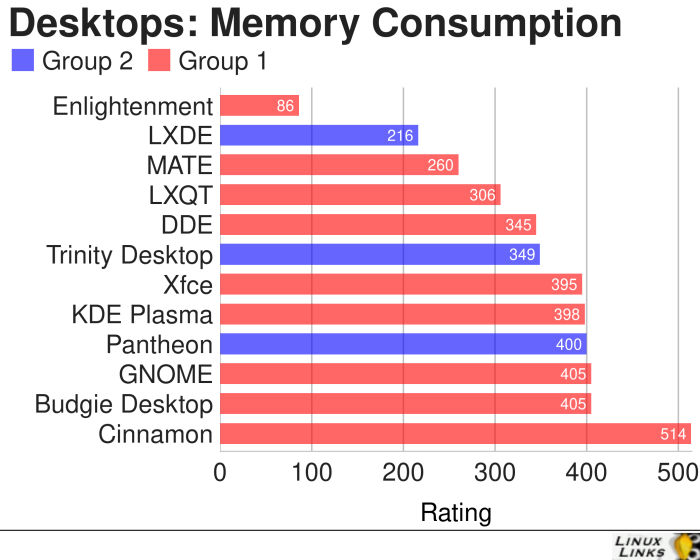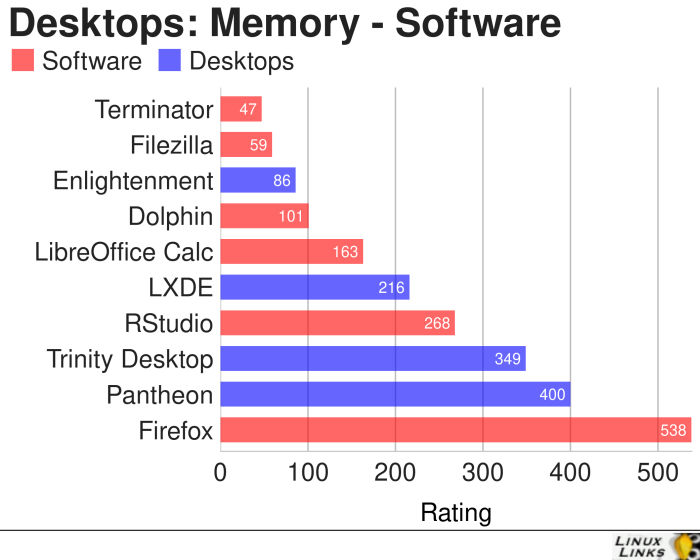Last Updated on May 27, 2022
System Resources
Whether your desktop is a memory-hungry monster is an important consideration depending on the amount of RAM in your computer. If you’ve got less than 4GB of RAM, and a weak CPU, it can be an important consideration.

Bear in mind that memory usage of a DE depends on many factors. For example, some distributions apply their own modifications to each environment.
Pantheon’s memory footprint is comparable to that of GNOME and KDE. CPU cycles are a bit lower but not that significant. And you’ll need to install Tweaks if you want to turn off animations.
Trinity’s desktop weighs in at a shade under 350MB RAM. It takes the middle group, a far cry from the lightweight Enlightenment, and offers modest savings compared to the mainstream GNOME and KDE.
LXDE proclaims that it’s both lightweight and fast. The developers say it uses less RAM and less CPU than other DEs. LXDE is especially designed for cloud computers with low hardware specifications, such as, netbooks, mobile devices (e.g. MIDs) or older computers. Our tests confirm LXDE is frugal with both RAM and CPU cycles. In fact, when surveyed against all the other DEs, only Enlightenment has a lower memory footprint.

It’s worth putting into context a desktop’s memory footprint by comparing it with other popular software. The chart above shows memory usage of Firefox, LibreOffice Calc, Filezilla, RStudio, Terminator, and Dolphin. To make for valid comparisons, the desktops were tested under Enlightenment.
Next page: Page 4 – Extensibility
Page 1 – Features
Page 2 – User Experience
Page 3 – System Resources
Page 4 – Extensibility
Page 5 – Documentation & Support
Page 6 – Development / Closing Thoughts
Learn more about the features offered by each desktop environment. We’ve compiled a dedicated page for each desktop environment explaining, in detail, the features each offers together with screenshots.
| Desktop Environments | |
|---|---|
| Pantheon | Showcasing the elementary OS |
| LXDE | Desktop environment with low resource requirement |
| Trinity Desktop | Qt3-based KDE 3.x form traditional computer desktop that is responsive |

I consider myself to be a power-user and use openSuse Leap 42.3 on my main workstation (HP xw8400) and prefer KDE Plasma for it’s configurability.
For my various laptop/netbook devices I settled on Lubuntu a couple of years ago because LXDE seemed to be lighter and faster than Xubuntu’s XFCE. Lubuntu 18.04 runs pretty much the same on my Acer One 110 Netbook, a Dell Inspiron 1300 and even a 12 year old Apple 13″ MacBook. That means I only need to keep up with 2 desktop environments. The one thing it lacks is a proper 2 panel file manager. I use Konqueror on openSuse which is IMHO the very best file manager around.
I agree with your view of LXDE, and would definitely recommend it, especially for older equipment and for Linux newbies.
As to TDE I only have one comment. It was designed for those who couldn’t drag themselves away from KDE 3.5! So obviously it has a more old fashioned look and feel. I did try it for a while as I needed Quanta+ for webdesign, but that now works fine on KDE 4.x so I left it behind.
Thanks for these interesting and informative reviews.
though LXDE is pretty much dead, I still enjoy the days when I ran LXLE as my main distro…
This comment was removed because it broke the rules. We don’t allow external links in comments. Explain.
To suggest an open source program, please complete this form.